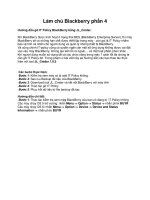iPhone Design Award-Winning Projects phần 4 ppsx
Bạn đang xem bản rút gọn của tài liệu. Xem và tải ngay bản đầy đủ của tài liệu tại đây (4.26 MB, 21 trang )
CHAPTER 3: Topple 2
51
Figure 3–6. The Plus+ leaderboard tracks a player’s progress in all Plus+ games combined.
The Plus+ network isn’t just limited to Ngmoco; the company has also developed an
SDK for other game-makers that want to join up. At first, the company will accept Plus+
partners on a case-by-case basis, but later the SDK will become open and available to
any game developer that wants to join. Not only will small-time developers get access to
Ngmoco's network of points, challenges and playability, they'll also be able to use the
company’s metrics and promotions engines.
But building the Plus+ network come at a substantial risk. Already, millions of people
have paid money for games that have since been made free—a textbook way to make
otherwise enthusiastic customers bitter. Asking players to sign up and divulge
information is another hurdle. Still, by building a network, Ngmoco will reduce the App
Store’s already-low friction between downloading, playing, and making in-app
purchases—one of the company’s planned conduits for revenue. Stevenson says he
envisions more future games that are downloadable and playable for free, but that give
players the option of buying additional features in-game to change the experience,
much like the buying experience inside other social games.
Despite all the potential for market share and upside, the Ngmoco team is still
possessed of a humble impulsion. “I feel like from a really young age when I started
playing games, I realized I wanted to change the rules,” says Ma. “I found a lot of
enjoyment not only from playing games but from also creating a different kind of game
for other people, and just having other people be happy felt great. That’s why I think I
always wanted to be a game maker.”
CHAPTER 3: Topple 2
52
53
53
Chapter
Q&A: Foursquare
Developer Name: Dennis Crowley and Naveen Selvadurai
Development Company: Foursquare
Tags: Visual Design; Connectivity; Client App; Workflow
URL:
Foursquare is a location-based social networking game that lets users “check-in”
at venues and meet up with friends nearby (Foursquare for iPhone is shown in
Figure 4–1). The app handily combines everything from Core Location to push
notifications, and its ambitions run deep. It aspires to be a multipurpose tool for
socializing, complete with Yelp reviews, maps, nearby tweets, and user profiles.
Despite its breadth, Foursquare maintains an economically-designed interface that
makes the iPhone’s screen feel bigger than it is.
Figure 4–1. Foursquare’s careful tabbed interface packs data into a friendly format.
4
CHAPTER 4: Q&A: Foursquare
54
Dennis Crowley and Naveen Selvadurai are Foursquare’s founders, and built Foursquare
for iPhone as a team. Determined to build their app as a standalone tool discrete from
Foursquare.com, Crowley and Selvadurai had to navigate not only technical challenges
but social consequences, privacy concerns, and new-user foibles. Tempted to explore
new UI elements but wary of scaring off new users, the pair has settled on a solid,
accessible design after studying some of the iPhone’s UI experimenters—two of whom
are featured elsewhere in this book.
Crowley is also the founder of a similar service called Dodgeball, which he and a partner
sold to Google in 2005. In addition to its iPhone iteration, Foursquare is available as an
Android app and on other phones via an SMS interface.
What was your plan for Foursquare for iPhone, and how did you divide the work?
Dennis: We knew we wanted to reproduce some of the features of Dodgeball, like the
fun-finder stuff. We knew conceptually that we wanted to make a smarter city guide. I
don’t think we’ve fleshed out all the conceptual hurdles yet. But we did a lot of paper
mockups, sketching things out on paper. Naveen has a pretty good sense for interaction
and design, so we just ran with a lot of that stuff; he was building much of the iPhone
stuff, and I was building the backend that would talk to the database. My work figured
out how [Foursquare] would spit out a bunch of data and he’d find a way to look it pretty
on the iPhone.
Is there a governing aesthetic?
Dennis: We’re trying to make it look different than other apps, and trying to find an
aesthetic that we like.
Naveen: Having a slightly different look is important to making [Foursquare] a standout
among all the other apps in the space. But it’s not just to make it look different; the other
factor is that we have so much information to cram on the screen. To show a lot of
different types of content, we had to introduce some new styles. You don’t necessarily
want to load all that data onto the same screen—even though we probably could’ve
done that—so we tried to set different priorities, since people place different weight on
different types of information.
For instance, for the user profile: you probably take a look at the badges tab maybe a
tenth of the time you do one of the other primary tabs. So we realized it has to be
cleanly pushed into some sort of side-loader section.
On the home screen, we decided the Check In button and the Shout button have to be
central. Not only does that show you information about yourself, and kind of give you a
list of all your friends nearby, but we realized that we needed a direct call to action.
Front and foremost is the idea of checking in, because without checking in, you’re not
going to get any of the other candy, you’re not going to be able to meet up with your
friends, or you’re not going to be able to earn badges, and so on.
CHAPTER 4: Q&A: Foursquare
55
Do you each have varying ideas about what information the user should be
presented with first?
Naveen: We do. One issue is the case of new users vs. experienced users, and that’s
some of the stuff that we’re iterating on right now. We put this [UI] together kind of
selfishly—we built it for our friends, and all those use-cases always involve, say, ten or
twenty friends. In other words, we built for people who already had Foursquare friends.
We realized after we got it out and after we started using it, that most users had only like
five friends, maybe ten at most, so we needed to make the experience really good for
them at the same time.
Your app relies heavily on tabs to sort information. Is this a good long-term
solution?
Dennis: We’re going through a UX redesign now. Those tabs are going to look a little bit
nicer. We’re trying to do a lot in the app. In fact, we might actually be doing too much;
we’ve got tabs in the bottom, tabs in the middle of the screen. All users have been able
to understand it, I don’t think it’s a huge technical challenge, whether it’s exactly the
right UX for that experience, I’m not sure. Some of the stuff we were just racing to get
done as quickly as possible [for South by Southwest] but a good 90% of it is pretty solid
and pretty functional.
Naveen: I actually had screenshots of every positive development. The tabbed browsing
was there from the beginning—I don’t even remember if there was a version before the
tab browsing where we tried to cram everything onto a single list. I think the way it
worked, we realized, was our menu screen had to have the ability to check in the ability
to see all that related stuff. But on the menu page users also want to see details: they
wanted to see a map, they wanted to see Yelp information, or which friends are at [a
venue].
So what are our options? We can either give them a button or some sort of table show
that is basically built into the view, and which basically says “tap here for more details.”
Or we can adopt some sort of tab approach. We knew we were going to have many
styles of data in the future, like a People tab in the menus, so we opted for the latter.
Did any apps serve as inspiration for Foursquare’s interaction design?
Dennis: The Facebook app, of course. And the apps that come free on the device, like
the ones that most people are used to playing with. Naveen and I have been going
through and looking at the latest round of Twitter clients, looking at some what some of
the clever UI looks like, and salivating over some of it, and wanting to build it in. Apple’s
re-standardizing a lot of their UI, because a lot of it has to go. The question is, should we
build that new stuff in? Do people understand how to use it?
1
1
To read more about Facebook for iPhone, turn to Chapter 2.
CHAPTER 4: Q&A: Foursquare
56
Naveen: I think Facebook still continues to standout in a good way, cause they have
very similar structured data in many different buckets, so to speak. One bucket of data
is the user’s profile, one bucket of data is the user’s News Feed, and so on—we’re very
similar in that sense.
I would also say that some of the elements in Tweetie are really nice, but what I think
what’s really confusing about Tweetie [2] is that it breaks the model of the navigation bar
at the bottom. One of the best parts about the toolbar is that there’s a definite hierarchy,
there are definite stacks, as soon as you tap any button in the toolbar, it’ll automatically
bring you back to the superview of that tab. But what Tweetie has done is take that idea
of the toolbar, and break that hierarchy, so the tabs are very much topic-sensitive; you
can’t really tap to go to the superview. I find it actually to be more difficult to follow than
all the other apps, because the hierarchy works when you’re drilling into it, but there’s
no way to come back to the top of the view to see all of my replies, or to see all of my
public online views. Maybe it’s because I’m a developer and I’m focused on the code
[behind] the tab approach.
2
Dennis: The new Tweetie does have a lot of cool stuff—there’s a little widget on the
140-character thing where you flip it and the screen pops up with a bunch of different
options; there’s the pull down the screen to refresh which we both like. There’s another
application called StarMap that is really great. It’s an astronomy program, it turns the
standard five-tab thing at the bottom of the screen so you can rotate it, which is kind of
hot. So because you can swivel it to see different views, you basically get 20 buttons
instead of 5 buttons.
Naveen: I think Joe [Hewitt] has really solved some navigation problems really well, with
the grid [button] at the top, which allows you to get to whatever view you want to. I
should add that one of the things I really appreciate about both Tweetie 2.0 and
Facebook is that they preserve not only all of your data, but the path you took to get to
that data. Your entire path into a view stack is saved. That’s part of what makes those
apps so fast and so efficient.
You use a lot of Apple’s frameworks. Why not source some of the work out to
Apple’s built-in apps?
Naveen: The more I started using the app, the more I realized there’s a lot of value in
keeping the user within our app as much as possible. It makes the experience easier. So
there’s more value in me being able to say, “Oh my friend is hanging out at this bar
downtown, Where is it?” And tap into a map in the app.
I can also see Yelp data from within the app, and I can see tweets nearby. I think it’s
kind of powerful because it keeps me in that mode of, “I’m looking at foursquare data
right now,” and I am not tempted to jump contexts. If the users really want to jump out
of our local native maps into the native Maps app, or if they really wanted to jump out of
the built-in tweet view into the native tweet view, they have that option. But I’m trying to
avoid that if possible, because I feel once you jump out of the app your train of thought
2
To read more about Tweetie, and Loren Brichter’s rebuttal to this critique, turn to Chapter 1.
CHAPTER 4: Q&A: Foursquare
57
is broken, and it’s harder to jump back in. Figure 4–2 shows Foursquare’s in-app tweet
stream, based on WebKit.
Now that you’ve cranked out your initial versions, how do you go about revising the
interface?
Dennis: There are certain screens in the app that we want to target first. The screens
with a lot of data on them—where we did the bare minimum of design—we need to
come back and really revisit. Our strategy is generally to do things piece by piece. A
couple of screens will get redesigned and then a couple more in the next revision, and
then after two or three more builds the whole thing will look totally different. First and
foremost, what we’re trying to do is cut down the number of tabs and taps that get you
to do whatever you want to do in the app.
Is it better to have more tabs and a cleaner interface, or fewer tabs and a more
crowded screen?
Dennis: I think over time different UIs from different apps have helped teach people how
to use apps differently. So rather than just having one row or one data element
represented by one tab, you can now have multiple tabs in a specific row, with different
items you can click on. I know people are doing more complex stuff as people are
getting more comfortable with the iPhone UX. I think users are becoming experts at it. I
don’t know if we’re the app to start inventing new UX widgets, but the apps that have a
critical mass of users, like the Facebook app and Tweetie and some of these other
clients with a large number of users, they can progressively expand. We might inherit
ideas from those guys.
Foursquare seems to rely heavily on WebKit. Why?
Dennis: A lot of the stuff we built in to the app was done with WebKit so that we could
change it very quickly with HMTL, and not have to create updates for the app. That’s
how the Leaderboard works. It’s also much faster for us to develop that way.
Naveen: The Leaderboard is a great example, because we weren’t sure at the time how
we were going to reveal stats about a user, but we knew there was going to be this
“leader board” concept that compared your points to your friends. We were playing with
the idea of using pie charts to display the data. We figured it would be a little more
dynamic if we could control it all on the server.
CHAPTER 4: Q&A: Foursquare
58
Figure 4–2. Foursquare’s app uses WebKit to allow its builders to iterate without resubmitting their app, and to
keep users inside from jumping out to another program.
Though Foursquare definitely has a unique visual design, Apple inspired some of
the smaller details, didn’t it?
Dennis: Yeah it did, with their App Store [Buy Now] buttons. We handed those off to our
designer, and she came back with little tweaks to it. I think when you look at some of the
sizing of those smaller elements, how they are supposed to work, and the minimal font
size, I think it’s safe to assume that Apple probably nailed it the first time, so we use
them as inspiration or guidance on how those things should look or be sized.
Naveen: That was actually one of the points I was debating, like how would I show that
button. I definitely did not want to show a native button, and I did not want to make a UI
table button. I looked around for a little bit and I realized Apple had come up with this
new style approach, this “call to action” button, you could almost call it. In almost every
case we only use one of those on any screen, and they almost always use one per item
sort of thing.
Certain screens of your app contain “help” text. How do you decide where and
when to include those instructions?
Dennis: Some of it comes from user experience and user feedback, where people are
like, “I don’t know what to do with this page” or, “This didn’t act the way I expected it
to.” And that’s just from aggressively testing with our friends and listening to their
CHAPTER 4: Q&A: Foursquare
59
feedback. I think one of the things we’re missing in the app is the welcome screen or the
walkthrough process, and that’s something you’ll see in the next build or the next two
builds, where we hold users by the hand and turn them from newbies into users.
Naveen: I think the only two places we really had any help text are the two places that I
felt that people would be turned off by a function, either because of privacy issues, or
from an annoyance standpoint.
The first place we use [help text] is when you add a friend; we make it known when you
add a friend that your phone number and your email are shown to them by default. We
wanted to make that clear there because we got a lot of complaints from users who
particularly just added anyone and everyone, and complaints from them that, “Hey they
can see my phone numbers, what’s going on?” And our approach is that it’s just easier
to have their phone number—they’re your friends, so you should be able to call them
and you should be able to go out and meet up with them. It’s like a Facebook-style
approach. On Facebook, if you’re friends with someone, of course you should be able to
email them. But we realized well we’re not like Facebook, we’re not that big, so we can’t
just get away with doing it without letting the user know.
The second instance we [used help text] was right after push notification was launched.
We wanted to be one of the first apps to use push, to really use it reliably, because we
realized that push is very valuable for an app like ours; it buzzes in your pocket if you
have a friend nearby. Of course power users were concerned—the people with 50 or
100 friends in there—that they would get very annoyed very quickly if they got a buzz in
their pocket for everyone of their 50 friends. So we made very clear our rules behind
pings and how we handle them: we basically said, “Hey, do you want to turn push off for
everyone, or do you want to turn it off for an individual user?” Then we told them,
“Here’s how you do it.” We had to be very clear and explicit about that because it’s a
feature that we launched after the fact. In other words, it’s a feature that will sneak onto
people’s phones through an update, so they may not realize it, and all of a sudden they
are going to get these messages.
Not only did we put the help text in the app, but also alongside the update for the app.
We sent out an email newsletter with the app that basically said, “By the way, you’re
going to notice this, but it’s going to give you hints on how to get fewer messages, or
how to make these messages a little more valuable.” Then we actually set up a web
page on our site that went into how do you most effectively manage 15 ping requests
from your friends—[questions] along those lines.
Do you use any wider system for collecting feedback?
Dennis: No, I haven’t looked at the iTunes reviews or anything in a long time. We use a
system called GetSatisfaction to collect feedback from users, it’s actually really
fantastic. We’re horribly far behind in the queue, but it’s great for aggregating and stuff,
we find that a lot of users are helping other users, too.
CHAPTER 4: Q&A: Foursquare
60
Did you assume that Foursquare for iPhone users had seen the Web service first?
Naveen: I don’t know what to think. I know a lot of people use something like Twitter,
and go to the web site for Twitter, and Facebook, too. Based on that, I didn’t think the
app would be this powerful where people would be experiencing [Foursquare] on the
iPhone first. A lot of our close friends hardly ever go to the web site. And we don’t really
push them to the web site; we want to build as much of the core experience into the app
as possible. But I still find it really surprising. I ran some numbers the other day, and I
realized that a lot of people that use the app use exclusively the app—it’s like they don’t
even know the web site exists.
Dennis: We kind of had intuited this when we were building things, so we built in a sign
up process. So this is totally opposite what Facebook does; Facebook’s first “in” is
through the web site, and there’s nothing else you can do. Sometimes I wish we had
that kind of power, because we’d be able to collect data; people are more likely to type
in their full names, phone numbers, email addresses, gender, and age on a web site.
Do you take user’s real-world behavior into account when you’re adding features?
Dennis: We’ve definitely learned some things since Dodgeball. Initially you’d get check-
ins from all of your friends across all cities, and you’d be like, “Why would I care what
coffee shop my friend is at in San Francisco?”
We realized that it’s not like collecting friends on Facebook—there’s some kind of
consequence to having too many friends, so we had build in a graceful way to say,
“Okay, I want to be friends with you, but I don’t want you to see my location.” We call
those “ex-girlfriend” bugs. There are situations like this that come up all the time; it’s
really interesting and fascinating stuff to play with.
There are all also all these odd niche behaviors that happen within Foursquare that we’re
learning from. We’ll have people that check in early at a place so they can draw a crowd
there, and we’ll have people that check in after they leave, because they still want to get
the points but they didn’t want anyone to show up while they’re there. We have people
that check in across time, so they can brag about places we know they weren’t at. At
the same time, there are people checking in at obscure places to throw people off their
course. There’s all sorts of weird stuff that goes on. On the data side we can tell, but we
really don’t care what people use this for; if people want to use it to mask their location,
that’s an important part.
But it’s different when you start adding the points, rewards badges, mayors and the
other [game] stuff. We’re working on is finding a way to say, “You’re a little bit too far
away from the coffee shop, so we’ll tell your friends you’re there, but we’re not going to
give you any points for it.” Figure 4–3 shows Foursquare’s list of nearby places.
CHAPTER 4: Q&A: Foursquare
61
Figure 4–3. Foursquare shows you what’s nearby, and lets notify your friends—or throw them off your trail.
Do you try to think one step ahead of Apple? Or take their iPhone OS revisions as
they come?
Dennis: I think we’re pretty reactive. I think both of us are pretty proficient at UX stuff,
but we’re not visionaries in it, and we’d prefer to leave the experimenting to Apple and a
bunch of the other apps that have extremely talented UX people. Through that evolution,
we’ll pick the UX elements that we decided are the most interesting or the most relevant
to our stuff.
Some of the things we’ve deliberately stayed away from: anything that involves the auto-
rotation of the phone, just because we both are not huge fans of it. We also haven’t
looked at doing [geo-location] maps because we didn’t want people to just be dots on a
map, initially; we wanted people to see past that. But now it’s at the point where I think
we should build that stuff in because it really enhances the experience.
What were some of the fights you had over user experience?
Dennis: Naveen and I are always arguing back and forth about what the next version of
the product is going to look like and what screens take priority. I think the most recent
one was about Apple’s pull-down search menus? They’re kind of hidden; you have to
scroll down until they appear. We were arguing whether that is standard UI, and whether
people understand how to use that yet. I’m saying it’s not implicit, and Naveen is saying
it is. It’s one of those things where we’ll probably build it in and run it by a bunch of
people. A lot of our changes come from very informal user testing.
CHAPTER 4: Q&A: Foursquare
62
Naveen: Regarding the search bar being hidden, I want to follow that path because
Apple has already done it. They set the precedent, so people are going to be responding
to that. I think it works well because it saves those 50 pixels in height, or whatever it is,
and it cleans up the interface a little bit. But it is more of a power user thing, and I
understand we have to build the app for both newbies and power users.
In fact, you could argue we have to build it more for the newbies than the power users.
63
Part
Using Compression to
Cram More Data into a
Local App–Large Images,
Geo Data, and Lots of It
Who says that a small computer has to run small apps?
Certainly no one at Intermap, makers of AccuTerra. This GPS-mapping app offers
thousands of square miles of hyper-detailed maps for iPhone users to examine,
breadcrumb, mark, and explore. Luckily for AccuTerra’s developers, Intermap already
had all that map data ready but it was no small challenge to slice it all into palatable,
usable parcels and then find a way to monetize the various parts.
Jonathan and Ashley Wegener, who built Exit Strategy NYC, faced the opposite
situation: a dead-simple idea for a useful app that required three months of subway-
riding just to collect the data that would be their core asset.
While both apps make good case studies in image compression, data handling, memory
management, and pricing, what makes them most interesting from a developer point of
view is the ambition behind their designs. Exit Strategy NYC went from being a nifty but
nichey subway app to a full-blown transit-map compendium that appeals to even the
most seasoned Gotham resident. AccuTerra improves the original conceit behind GPS
apps “you are here” by adding additional layers of information: hydrological
information, route maps, elevation, weather and a planned implementation of
augmented reality on top of it all.
III
64
What keeps these apps happily earthbound and ultimately so useable, is both
developers’ keen adherence to carefully-planned release strategies. They’ve started with
the bare minimum, and tolerated the customer complaints and one-star reviews, all in
the name of iterative design. It’s not just design but patience, their stories suggest, that
is crucial to making a data-heavy app possible and profitable.
65
65
Chapter
AccuTerra
Developer Name: Dave Witonsky and Randall Barnhart
Development Company: Intermap
Tags: Compression; Efficient Code; Release Strategy
URL:
“We have roughly 170 products on the shelf today,” says Dave Witonsky, head of
smartphone development for Intermap. He's not talking about apps. He's talking
about in-app purchase items: hyperdetailed maps that users can buy and
download as they travel. Welcome to the dizzying world of AccuTerra: the iPhone’s
titanic terabyte app (see Figure 5–1).
Figure 5–1. “I want this app to help people plan their trips, view their trips, and share them. I want it to enhance
that experience of being in the outdoors,” says Witonsky.
5
CHAPTER 5: AccuTerra
66
Unlike the rest of the apps profiled in this book, AccuTerra, which won the ADA for beta
use of iPhone OS 3.0, was awarded an Apple Design Award not for what it did, but for
what it has the potential to do. And although Intermap's app is now in the App Store, it’s
still AccuTerra’s incredibly ambitious roadmap that sets it apart from the crowd. And
although not every developer has access to the mapping data from a multimillion-dollar
navigation company, AccuTerra shows how developers of all stripes can build massive
data-intensive apps—and do it profitably.
Building a Framework
Intermap is not just an iPhone development shop; it’s a map-data provider. “We have
flown all over the U.S. and western Europe to collect highly detailed mapping and
elevation information,” Witonsky explains, “and we have very accurate models of the
earth that contract out to governments, flight insurance companies, and OEM personal
navigation companies.” Intermap, in other words, is not your average Mac shop that has
decided to tool around with a new platform. In building a deeply complex app, they have
a lot at stake.
NEXTNat, the company’s name for its map data, gets around because of its level of
detail: automotive, trucking, and flight companies use Intermap’s data because it
includes elevation, hydrological data, and other matrices of info. Witonsky says that
Intermap saw that personal navigation devices were giving way to smartphones, and
they figured they could ditch the middlemen—companies that make personal navigation
devices—and bring their data straight to consumers. “So we built early prototypes for
the iPhone, and of course, this tsunami of popularity came,” Witonsky says.
As the iPhone proliferated, the scope of Intermap’s app expanded. “We focused first on
national park trails and research, and then pulled these trails and description and
attributes from guidebooks and other public sources,” Witonsky says. Then his team
consolidated and verified their data, and started working on making the rest of the
nation’s detailed maps available, too. Witonsky wants AccuTerra to someday be a one-
stop outdoor guide for the entire contiguous Untied States. “Eventually I’ll be able use
the app to put in, say, Mars, Colorado, and choose [trails of] moderate difficulty,” he
says. “Then let’s say I’d rather not see what’s called tight-usage, or trails with horses
and mountain bikers on it; I’d rather just hikers-only. The way we’re building this thing,
we can provide them two or three choices based on our algorithm. The next thing the
person will want to know is the 3D profile, which will leverage our NEXTNat high-
resolution elevation model. They can see how steep a trail is.” Figure 5–2 shows
AccuTerra’s information dashboard.
CHAPTER 5: AccuTerra
67
Figure 5–2. AccuTerra pays attention to all the available data about your trip recording.
As opposed to some of the other navigation apps that leverage Google Maps or Open
Street maps, AccuTerra uses all of Intermap’s own map data. “Other apps could
integrate to the MapKit framework and get things out faster,” Witonsky says. “Our value-
add, a big one, is that we’re onboard. We used our own mapping framework; we built it
from scratch.”
“We did take a lot of cues from MapKit,” says Randall Barnhart, the lead developer of
Intermap’s five-man team. “And we do also use MapKit to interface with Google, so that
we can provide people who are doing recordings in an urban area with the option of
using Google maps instead [of Intermap’s] if they want.” But building their custom map-
kit was the brunt of the work behind the app. “It was an absolutely massive
undertaking,” Witonsky says.
Intermap’s other killer feature is detail. But being able to fetch a detailed map of every
square mile of the U.S. requires a lot of images—far too many for a single app, or even
for a dozen apps. The team decided to build an in-app map store so that users could
buy detailed maps as they needed them over their 3G connection, delete old ones if
they needed space, and re-download the ones they’ve already bought. Along the way,
they had to figure out how to mate their purchasing back-end with Apple’s, and how to
deliver gigabytes of map data over the air.
CHAPTER 5: AccuTerra
68
Divide and Conquer
Apple’s terms and conditions require that all in-app purchases go through the App
Store. There are ways around that—several e-book apps have eschewed the rule—but
Witonsky thought it better to stay on Apple’s good side if his company was going to
pour so much money and effort into their app. But following the rules meant that map
downloads and payments would have to take a convoluted route.
“We made the decision that we were going to rasterize all of these trails and all the
different levels of detail—hydrology layers and so on—all in the raster image,” Witonsky
says. “When these maps raster, when you start talking about an entire state, the
country, earth, this stuff is heavy. Even if you’re using PVRTC, if you’re at high-resolution
these things are 512kb per tile. It adds up real quickly.”
Had they packaged the entire app with every available U.S. map, Witonsky says, it
would have been well over a terabyte. “We considered going out the door with different
states bundled with our application,” he says. “Each bundle, of course, would be one
app on the App Store that we could charge someone $10.00 for. By the time we split up
all the states, and the larger states into sections, lo and behold, we were up to 70
bundles. It was just too confusing.” IPhone OS 3.0 brought in-app purchasing, saving
Intermap from having to inundate the App Store. Instead, it built a map store inside
AccuTerra. “We figured we could release this one app, and sell the other maps
piecemeal—though the basic app is a bit heavy at 110MB because it contains
continental data. But on top of that, we figured we could side load these other contents:
your wide-area maps, big states, national parks and recreational areas.” (Figure 5–3,
AccuTerra’s pre-installed “continental” view of New York.)
Figure 5–3. AccuTerra provides users with an overall view, but for more detail, additional maps must be purchased.
CHAPTER 5: AccuTerra
69
AccuTerra’s map store is entirely separate from the App Store, but it must communicate
with Apple’s servers to coordinate purchases. To make the hand-off fluid, Intermap’s
engineers designed their in-app catalog to be consonant with the Apple experience.
“The map store is highly modeled on the actual App Store itself,” says Barnhart, who
began his career at defense contractor Raytheon doing Java work application
development. “How we categorize products, how we have these table views; how you
tap a row, get more information about it, or go down a level; we’re using a lot of the built
in UI-kit user interface to do a lot of the same things that you’d see in Apple native
apps,” he says.
In-app purchases in AccuTerra deliver tiles of a region in various resolutions: the
medium-quality Continental maps are what Intermap calls 32-degree/8-degree/2-
degree-quality images, and the higher definition maps, used in parks and recreational
areas, are designated 30-minute/7.5 minute/2.5 minute images. “That is a full stack
stored locally, so when you pinch and zoom, you’re not connected over 3G or WiFi,”
says Witonsky. “This is a huge thing for us, because our maps are resident on the
device, unlike Google Maps which come in over the network.”
The levels of detail depend on the area a user buys. If you in-app purchase a state, and
you get the 30 minute and 7.5 minute-level of detail; when they get the national parks
and other high-use recreational areas, you get 2.5 minute-level maps, which are higher
resolution. Future versions of AccuTerra will go even more in-depth. “We’re creating
version 2.0 of AccuTerra, which will have more trails, better roads, everything—and for
that we’re creating all new 30s, all new 7.5s, and 2.5s for the whole U.S.,” Witonsky
says. Translation: the app’s enormous 400-600MB maps are getting even heavier.
Witonsky says he’ll solve the problem by making the app-buying location-aware: drive
to a trail-head and the app gives you the option of downloading a map of the five
square miles around you. “This is where on-demand buying becomes appealing,”
Witonsky says. “If we split the maps into five-square-mile tiles, each one ends up less
than 10MB and I can download it via 3G or EDGE.” Figure 5–4 shows a list of maps
available for sale.
CHAPTER 5: AccuTerra
70
Figure 5–4. A list of maps for sale inside AccuTerra.
Building an In-App Store
Apple’s restrictions made AccuTerra’s massive in-app catalog a peculiar task. Because
the maps are what Apple deems a “non-consumable” product, Intermap has to register
each purchase on its server, so that the system knows which maps a user has bought,
and won’t make him pay if he wants to download that same map again. But because
Intermap can’t access a user’s iTunes account name for privacy reasons, they have to
ask each customer to sign up with new credentials on a separate Intermap system.
“There’s a real twist when it comes to managing your content, because as the developer
I have to give you the ability to uninstall a given state map to free up space,” Witonsky
says. “But I have to list that map in my store as ‘uninstalled’ status so that you can get
that map again. But because StoreKit doesn’t track your purchases, at first the App
Store doesn’t know you already purchased this state. So we have to pop up a little alert,
and say, ‘Hey, if you bought this under the same iTunes account, you’re not actually
going to be charged, even though the in-app store says ‘buy,’” he explains. “Once you
hit ‘buy’ again, we get that transaction, we know you already bought it, and our server
sends it back to your phone for free. That’s how you have to manage selling a large set
of data.” Figure 5–5 shows a catalog listing for the New York State map; Figure 5–6
shows a map’s coverage area.
CHAPTER 5: AccuTerra
71
Figure 5–5. State and regional maps vary in price and size.
Barnhart says the trickiest part was keeping the sets of information straight. “Developing
the in-app store capability raised a lot of issues, since we have our own server that
keeps track of users and what map they’ve downloaded,” he says. “But at the same
time, there’s Apple’s framework StoreKit, which also enabled the e-commerce
transaction to take place using the person’s iTunes account. So we have a bit of
duplicate information there, as far as the names of things purchased. So an interesting
thing from our side is that our server has to go out and we look for our list of products,
then have to come back and make a request out to Apple to say, ‘Okay, which of these
products on your side are also signed with the same information and are ready for sale?’
Then we use that list to display to the user what is ready for purchase,” he says. He
contrasts the experience to selling apps for Google’s Android platform. “We didn’t go
out and do our own e-commerce thing, because we were bound by Apple’s terms and
conditions. But if you go to a different platform like Android, all the people that are doing
e-commerce through their app are just essentially connected to their own server.”
The in-app purchase system also creates confusion when it comes to documenting
purchases—something that is crucial when a user can spend upwards of $200 inside a
single app. “There are issues with keeping track of receipts and transactions that Apple
has on their side, versus transactions and receipts that we’re tracking,” Barnhart says.
“For example, what happens if someone interrupts the download halfway through?
What’s the best way for us to resume? Is it to go through Apple and see if they have that
same transaction, or should we go through our server side? Or do we go through both?”
Eventually, Intermaps’ engineers figured out that the best way to handle this scenario
Download at WoweBook.com









